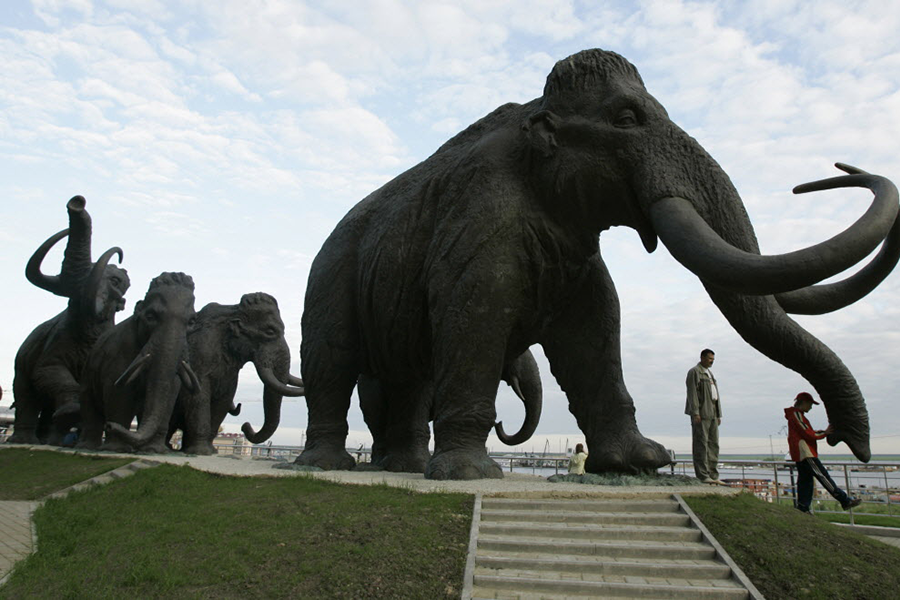Were the last North American woolly mammoths parched when they died?
Loading...
Most woolly mammoths and other massive ice age creatures disappeared from the American landscape more than 10,000 years ago. But a few island-dwelling mammoths hung on for thousands of years longer.
On the remote Saint Paul Island in Alaska, mammoths went extinct only about 5,600 years ago, according to a new study published in the journal Proceedings of the National Academy of Sciences. And scientists think they know what killed them.
No, the culprit wasn't humans, the researchers say. Humans didn't discover the island until the 18th century. It was more elemental than that: water.
"Freshwater resources look like the smoking gun for what pushed them into this untenable situation," said Matthew Wooller, director of the Alaska Stable Isotope Facility at the University of Alaska Fairbanks and a co-author of the study, in a press release.
Here's what probably happened, according to the team's research:
Rising sea levels shrunk the island down to its current size of about 40 square miles in the millennia leading up to the extinction event. This meant that the humongous animals' stomping grounds, and therefore resources, had shrunk.
Shallow lakes provided the island's fresh water, but as the ocean rose, salt water would have seeped into them.
At the same time, the climate was getting drier, so the mammoth's drinking water supply was shrinking even without the sea's influence: bad news for the huge, thirsty animals.
And the mammoths weren't making life easier for themselves, say the researchers. They found evidence that the megafauna were eating up all the vegetation around the lakes, which would have caused erosion.
"They were actually causing the lake to infill – it's sort of an ironic situation," study lead author Russell Graham, a vertebrate paleontologist and geoscientist at Pennsylvania State University, told New Scientist.
"They sort of hastened their own demise," Dr. Graham told the Atlantic.
Damning dung
"To me, the coolest thing about this work is that we actually figured out why the population went extinct! As far as I know, this is the first time that anyone has been able to do this for a population that disappeared more than 5,600 years ago," study co-author Beth Shapiro, an evolutionary molecular biologist at the University of California, Santa Cruz, tells The Christian Science Monitor in an email.
How did they do it?
The team found mammoth remains in a cave on the island, but that wasn't enough. They also extracted sediment cores, which serve as a sort of natural history book, from a lake near that cave. They perused the cores, centimeter by centimeter, to look for clues into the island's history.
Dr. Shapiro, an expert in ancient DNA analysis, poked through the sediments for mammoth DNA while colleagues looked for three kinds of fungal spores found in mammoth dung. Mammoths, being huge animals, produce a lot of dung, so the presence or absence of these fungi are a good indicator of the absence or presence of mammoths, she says.
"We would not have been able to solve the puzzle with just pollen, or just plants, or just DNA, etc," Shapiro says. "It really was the combination of all of the different proxies that led us to the answer."
And the different lines of independent evidence agreed: The mammoths went extinct 5,600 years ago, give or take about 100 years.
Although the St. Paul Island mammoths lived surprisingly recently, an even "more recent surviving population of mammoths" survived until around 4,000 years ago on Russia's Wrangel Island, she says.
Megafaunal mysteries
Scientists have long puzzled over the extinction of megafauna across the world. In this prehistoric whodunit, some researchers point to climate change as the culprit, while others say humans hunted them to extinction. Most say it was a combination of the two.
That debate still rages on, but the mammoths on St. Paul Island present a "unique situation," Shapiro says.
"The St. Paul population is a single population of mammoths that disappeared without any humans around," she says. "This shows us how it is possible that a combination of environmental impacts really can have devastating consequences to a population."
Perhaps if this mammoth population had lived on the mainland it wouldn't have gone extinct from thirst, Shapiro muses. But then it would have had to deal with people.
"I think one thing that this study shows is how hard it is to disentangle all of the different things that affect a population," she says. "Because these animals were trapped on an island, freshwater was their limiting resource."
Had other large mammals been there competing for the limited resources, the mammoth population might have gone extinct earlier, Shapiro says. And if humans were there, she says, they likely would have hunted the mammoths to extinction.
This story isn't just about the distant past, her colleague Graham told the Atlantic. It's playing out today, too.
In areas like the South Pacific, he said, "There are islands where people are having a hard time getting enough fresh water. If the sea level continues to rise, it will continue to get worse. Florida is in the same boat. People are standing on the beach and waiting for big waves to come in and flood the state, but really the salt water is coming in from below their feet. It will really limit the availability of fresh water."






